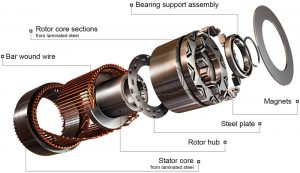There are many types of permanent magnet synchronous motors, which can be divided into sine wave permanent magnet synchronous motors and trapezoidal wave permanent magnet synchronous motors according to the waveform of the stator winding induced electromotive force. In the structure of touch screen maintenance in the composition of machine tool equipment, the stator of the sine wave permanent magnet synchronous motor used is composed of three-phase windings and iron cores. The armature windings are often connected in a Y-shape and short-distance distributed windings are used: the air gap field is designed as a sine wave, to generate a sine wave counter electromotive force; the rotor uses permanent magnets instead of electric excitation.
At present, there are mainly two control methods for three-phase synchronous motors, one is other control type (also known as frequency open-loop control); the other is self-control type (also known as frequency closed-loop control). The other control method mainly adjusts the speed of the rotor by independently controlling the frequency of the N#I-part power supply. It does not need to know the position information of the rotor, and an open-loop control scheme with a constant voltage-frequency ratio is often used. The self-controlled permanent magnet synchronous motor also adjusts the rotor speed by changing the frequency of the external power supply. Unlike the other control type, the change of the frequency of the external power supply is related to the position information of the rotor. The higher the rotor speed, the higher the stator energization frequency. The rotor speed is adjusted by changing the frequency of the applied voltage (or current) to the stator winding.
Because the self-controlled synchronous motor does not have the out-of-step and oscillation problems of the other-controlled synchronous motor, and the permanent magnet of the permanent magnet synchronous motor does not have brushes and commutators, which reduces the volume and quality of the rotor and improves the Response speed and speed range of the system, so we use a self-controlled AC permanent magnet synchronous motor. When the three-phase symmetrical power supply is added to the three-phase symmetrical winding, a synchronous rotating stator magnetic field will naturally be generated. The rotational speed of the synchronous motor rotor is strictly synchronized with the frequency of the external power supply and has nothing to do with the size of the load.
The working principle of pmsm motor is the same as that of the synchronous motor. PMSMs are widely used now, and like induction motors, they have commonly used AC motors. The characteristics are: during steady-state operation, there is a constant relationship between the rotor speed and the grid frequency n=ns=60f/p, and ns is called synchronous speed. If the frequency of the power grid is constant, the speed of the synchronous motor is constant at a steady state regardless of the size of the load.
Operating as a generator is the most important operating mode of a synchronous motor, and operating as a motor is another important operating mode of a synchronous motor. The power factor of the synchronous motor can be adjusted. In the occasions where speed regulation is not required, the application of a large synchronous motor can improve the operating efficiency. In recent years, small synchronous motors have been used in variable frequency asynchronous motors, also known as induction motors, which are an AC motor that generates electromagnetic torque through the interaction of the air gap rotating magnetic field and the induced current of the rotor winding, thereby realizing the conversion of electromechanical energy into mechanical energy.
① Establishment of the main magnetic field of the pm motors: The excitation winding is supplied with a DC excitation current to establish an excitation magnetic field between polarities, that is, the main magnetic field is established.
② Current-carrying conductor of pm motors: The three-phase symmetrical armature winding acts as a power winding and becomes the carrier of induced potential or induced current.
③ Cutting motion of pm motors: the prime mover drags the rotor to rotate (input mechanical energy to the motor), and the excitation magnetic field between polarities rotates with the shaft and cuts the stator winter phase winding in sequence (equivalent to the conductor of the winding reverse cutting the excitation field )
④ Generation of alternating potential of pm motors: Due to the relative cutting motion between the armature winding and the main magnetic field, a three-phase symmetrical alternating potential with periodic changes in size and direction will be induced in the armature winding. AC power can be provided through the lead wire.
⑤ Alternation and symmetry of pm motors: Due to the alternating polarity of the rotating magnetic field, the polarity of the induced potential is alternated, and the three-phase symmetry of the induced potential is guaranteed due to the symmetry of the armature winding.
